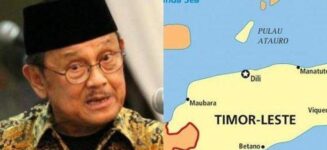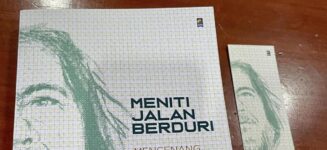Aboeprijadi Santoso, Jakarta – The Jakarta Post Tuesday, July 22, 2008
The final report of the Indonesia-Timor Leste Truth and Friendship Commission (CTF), titled Per Memoriam ad Spem (Through memory toward hope) is a political document of compromise rather than a complete and verified factual report on what, when and why violence occurred in connection with the August 1999 popular consultation in East Timor.
Indeed, it has been intended as such from the very inception of the CTF. Its aim is to bury not just the 1999 issue but the whole tragedy of the East Timor conflict.
These two nations were involved in one of the thorniest and bloodiest conflicts in Asia. It was resolved through a United Nations agreement and plebiscite in 1999 which resulted in establishing Timor Leste as an independent state. But the plebiscite ended badly. The ensuing mayhem has plagued the two countries in recent years.
Once these neighboring states were forced to address the issue of truth and justice concerning their common past, they unfortunately chose to jointly ignore the greater part of a quarter century of conflict which began with aggression (1974). continued with invasion (1975) and escalated to war and, on an even greater scale, to crimes against humanity with the bloody
Matebian encirclement (1975-1978) and other atrocities.
Instead the CTF, constituted in 2005 and consisting of experts from the two states, focused on the violence in the run up to the plebiscite and thereafter.
Now, with the conflict resolved and the long-awaited CTF report focusing exclusively on the 1999 mayhem and thus politically constrained by its terms of reference, probably neither will the victims’ families ever receive recognition nor will the full truth of the whole conflict ever be established.
The commission said they recognized the important influence of pre-1999 events on the period they investigated. They claimed to have considered the four key documents related to justice efforts and processes: Indonesia’s human rights commission preliminary investigation, KPP-HAM; Indonesia’s ad hoc human rights tribunal; The UN-sponsored Timor Leste Serious Crimes Unit investigation; and Timor Leste’s Commission for Reception, Truth and Reconciliation report.
But since they chose to resolve only the concluding episode of violence from April to September 1999 — a period which consumed so much domestic and international attention that the two states could not avoid addressing it — the CTF thus becomes a most pragmatic method to deal politically with the easier part of the conflict.
In addition to this political choice, three basic premises shaped the terms of reference, leading the commission to find results that more or less satisfy both sides instead of the full truth. The two governments have prescribed the commission, first, to seek a consensus without voting, second, to identify not individuals but institutions responsible for the violence and, third, not to ask for prosecutorial justice.
The implication is those responsible for the violence are not to be prosecuted. This is tantamount to perpetuating impunity; the UN has lodged its protest by refusing to attend CTF hearings.
The CTF final report, therefore, is a political discourse framed by the two states to bury the shame and human tragedy once and for all in order to foster friendship between states — leaving several truths — most of the conflict’s tragic history ignored, hundreds of thousands of victims’ families left unrecognized, and the questions of justice and reparation cast into limbo.
However, Indonesia was not only found guilty for the 1999 violence that took about 1,400 lives but they accepted the report. This fact should be appreciated.
Strangely, though, the commission referred to the reforms that engulfed Indonesia after 1998 to explain the mayhem. The killings, rapes and scorched earth policy in East Timor were ascribed to vast changes toward law enforcement and respects for human rights.
Evidence suggests that the police, then under the authority of the military, were in a state of disarray. By contrast, far from being confused, the military had a clear plan and developed a network of intelligence and political support. As the commission confirmed, they indeed sponsored, financed, trained and armed local civilian groups called “pro-autonomy militias”. In fact, some of these groups had been set up was early as the 1970s in other guises.
The argument the violence may have been triggered by confusion stemming from he democratic transition in Jakarta is unconvincing. Some of the violence and destruction directed at former Indonesian properties resembled retaliatory violence exercised not only in Timor Leste but in Aceh and elsewhere after the national political reforms introduced human rights imperatives.
To say, moreover, that the mayhem might have been a consequence of a transitional power vacuum is to deny the very responsibility for conducting a peaceful public consultation which Jakarta insisted it would take on in the Indonesia-Portugal Agreement of May 1999.
Indeed, as the CTF report points out, themilitary has yet to offer a coherent explanation for the existence and role of the militias accused of being the primary perpetrators of the violence.
While Gen. Adam Damiri explained that these militias were not part of any lawful armed civilian groups, Gen. Zacky Anwar Makarim argued almost the contrary: the militias were indeed an unlawful project planned to keep East Timor on board.
The CTF report needs to be viewed as a way to get past this issue and refocus on pushing for reform of Indonesia’s military.
For Timor Leste, however, the CTF recommendations may be more significant as that country, flanked by such a giant neighbor, needs greater assurance for its survival and long-term stability. It’s a geopolitically awkward predicament, a bit similar to Finland during the Cold War which had to maintain strict neutrality vis-a-vis the neighboring Soviet Union.
Hence, the CTF report is basically a geopolitically constrained document that tellsits readers a story of mayhem which ends somehow happily for the sake of friendship between the twostates.
But, given the report ignores the greater tragedy perpetrated during the pre-1999 period of conflict, it’s certainly an unhappy story to the many in Timor Leste victimized during the conflict.
Alas, to them, the two heads of states who received the CTF report, said nothing. And to the 1999 victims and victims’ families, they only offered “deep regret”. No mea culpa. No apology.
The writer is a journalist who covered the 1999 East Timor mayhem for Radio Netherlands.
This article is also published in
http://www.etan.org/et2008/7july/26/22ctf.htm




One Reply to “CTF report: Burying some inconvenient truth”
Comments are closed.